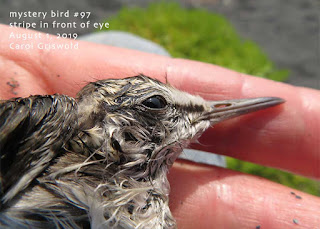Seward, Alaska
During the August 1, 2019 COASST beach survey, I discovered a small mystery bird floating at the edge of the tide. I have no idea what species it is, but it looks like a juvenile. The eyes were still bright, so it was fairly fresh.
It has 1 short toe behind and 3 long toes in front which key out to Shorebird, with yellowish legs, eye stripe, straight bill, and inner white wing stripe. What is odd is two, much longer tail feathers trailing out.
The bill is 15.8 mm long, the wing chord is 5.8 cm, and tarsus 25.1 mm.
I appreciate any help with identification.
For more information on COASST, Coastal Observation and Seabird Survey Team, go to https://coasst.org
For more information on COASST, Coastal Observation and Seabird Survey Team, go to https://coasst.org
Thank you and
Happy Birding!
Carol Griswold
Seward Sporadic Bird Report Reporter
September 1 update:
Many thanks to all who responded so quickly: Aaron Lange, Dave Sonneborn, Carla Corin, Martin Renner, and Jim Stevenson. Juveniles are notoriously difficult regardless of species, including humans (thanks, Jim!).
Questions arose as to how quickly the bill grows: in proportion to the bird, or like Pinocchio caught in a lie. The two long tail feathers posed another question.
However, the consensus (drum roll please) was juvenile SPOTTED SANDPIPER.
This makes sense as the immediate area is a known nesting site, though I hardly saw any Spotted Sandpipers throughout this summer.
I really appreciate the birding community that is so willing to provide expertise, and this Internet forum that makes it possible. Thank you!











